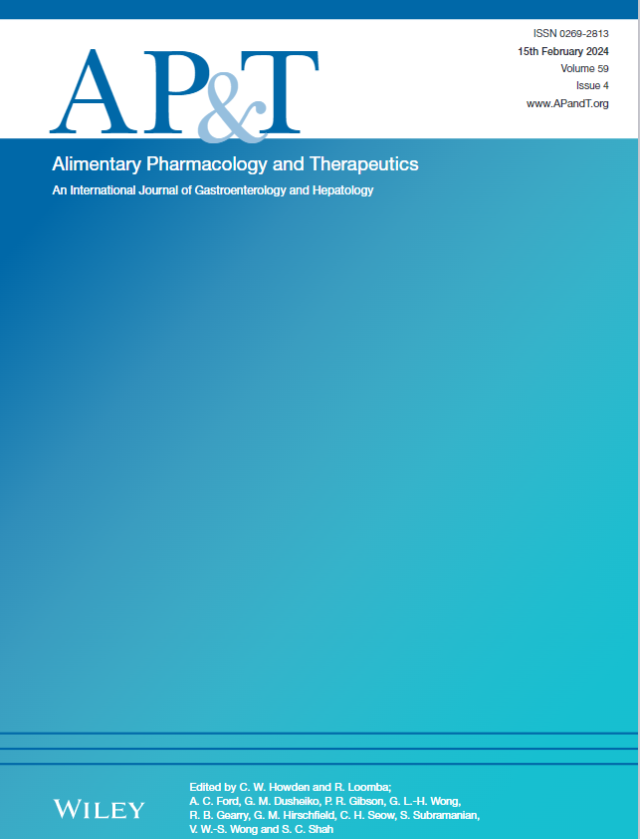Surviving Hepatitis C-Understanding Death and Survival Beyond Cure.
IF 6.6
1区 医学
Q1 GASTROENTEROLOGY & HEPATOLOGY
引用次数: 0
Abstract
BACKGROUND AND AIMS Cure of hepatitis C virus (HCV) infection decreases liver- and all-cause mortality. However, the risk of early mortality after HCV cure remains. We examined factors associated with cause-specific mortality after direct-acting antiviral (DAA) therapy. METHODS DAA-treated adults (recruited 2016-2021) were followed up to September 2023. Medication, health-service use, and deaths were obtained from population databases. The primary outcome was all-cause and cause-specific mortality. RESULTS Among 3619 patients (average 52.0 years (SD = 10.5), 66.0% male, 33.6% with cirrhosis) followed for a median of 6.8 years (IQR 5.5-7.4), 423 (11.7%) died (40.6% due to liver disease, 13.2% self-harm/accidental poisoning and 12.3% respiratory disease/lung cancer). Cirrhosis (adjusted hazard ratio (adj-HR) = 14.51, 95% CI 6.87-30.64), FIB4 > 3.25 (adj-HR = 4.22, 95% CI 2.63-6.80), nonsustained virological response (SVR) (adj-HR = 3.94, 95% CI 2.64-5.88) and age ≥ 60 years (adj-HR = 1.88, 95% CI 1.32-2.69) increased liver-related mortality risk. Mortality was threefold higher in non-SVR (32.4% of 210 patients vs. 10.2% of 2894 with SVR, p < 0.001). Non-SVR increased risk of liver mortality (adj-HR = 4.30, 95% CI 2.90-6.37). Mental health medication use (adj-HR = 2.82, 95% CI 1.40-5.67), loss to clinical follow-up (adj-HR = 2.61, 95% CI 1.31-5.21) and injection drug use/opioid replacement therapy (adj-HR = 2.26, 95% CI 1.23-4.14) increased risk of self-harm/accidental poisoning-related mortality. Age ≥ 60 years and diabetes increased mortality risk from other extrahepatic cancer (adj-HR = 2.68, 95% CI 1.31-5.51 and adj-HR = 2.57, 95% CI 1.15-5.72) and cardiovascular disease (adj-HR = 2.71, 95% CI 1.06-4.19 and adj-HR = 2.28, 95% CI 1.03-5.05). CONCLUSIONS Liver-related death drives mortality for cirrhotic patients. Curing HCV remains critical. Holistic HCV care, with attention to mental health illnesses in younger patients, metabolic comorbidities, and better cancer screening for older patients may reduce excess mortality.丙型肝炎的生存——了解死亡和无法治愈的生存。
背景和目的丙型肝炎病毒(HCV)感染的安全性降低肝脏和全因死亡率。然而,丙肝病毒治愈后早期死亡的风险仍然存在。我们研究了直接作用抗病毒(DAA)治疗后与病因特异性死亡率相关的因素。方法接受sdaa治疗的成人(2016-2021年招募)随访至2023年9月。从人口数据库获取药物、保健服务使用和死亡情况。主要结局是全因死亡率和病因特异性死亡率。结果3619例患者(平均52.0岁(SD = 10.5), 66.0%为男性,33.6%为肝硬化)中位随访6.8年(IQR 5.5-7.4),死亡423例(11.7%),其中40.6%死于肝病,13.2%死于自残/意外中毒,12.3%死于呼吸系统疾病/肺癌。肝硬化(校正危险比(adi - hr) = 14.51, 95% CI 6.87-30.64)、fifi4 bbb3.25 (adi - hr = 4.22, 95% CI 2.63-6.80)、非持续病毒学反应(SVR) (adi - hr = 3.94, 95% CI 2.64-5.88)和年龄≥60岁(adi - hr = 1.88, 95% CI 1.32-2.69)增加了肝脏相关死亡风险。非SVR组的死亡率高出三倍(210例患者中32.4% vs 2894例患者中10.2%,p < 0.001)。非svr增加肝死亡风险(j- hr = 4.30, 95% CI 2.90-6.37)。精神健康药物使用(adjh = 2.82, 95% CI 1.40-5.67)、临床随访缺失(adjh = 2.61, 95% CI 1.31-5.21)和注射药物使用/阿片类药物替代治疗(adjh = 2.26, 95% CI 1.23-4.14)增加了自残/意外中毒相关死亡的风险。年龄≥60岁和糖尿病增加了其他肝外癌(adi - hr = 2.68, 95% CI 1.31-5.51, adi - hr = 2.57, 95% CI 1.15-5.72)和心血管疾病(adi - hr = 2.71, 95% CI 1.06-4.19, adi - hr = 2.28, 95% CI 1.03-5.05)的死亡率。结论银相关死亡影响肝硬化患者的死亡率。治疗丙型肝炎病毒仍然至关重要。全面的HCV护理,关注年轻患者的精神健康疾病、代谢合并症,以及对老年患者进行更好的癌症筛查,可能会降低过高的死亡率。
本文章由计算机程序翻译,如有差异,请以英文原文为准。
求助全文
约1分钟内获得全文
求助全文
来源期刊
CiteScore
15.60
自引率
7.90%
发文量
527
审稿时长
3-6 weeks
期刊介绍:
Alimentary Pharmacology & Therapeutics is a global pharmacology journal focused on the impact of drugs on the human gastrointestinal and hepato-biliary systems. It covers a diverse range of topics, often with immediate clinical relevance to its readership.

 求助内容:
求助内容: 应助结果提醒方式:
应助结果提醒方式:


